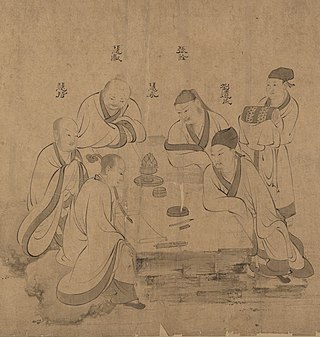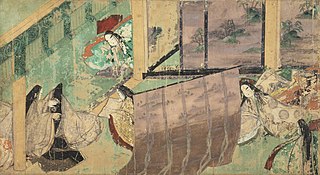
Vajrayāna, also known as Mantrayāna, Mantranāya, Guhyamantrayāna, Tantrayāna, Tantric Buddhism, and Esoteric Buddhism, is a Buddhist tradition of tantric practice that developed in Medieval India and spread to Tibet, Nepal, other Himalayan states, East Asia, and Mongolia.

Religion in China is diverse and most Chinese people are either non-religious or practice a combination of Buddhism and Taoism with a Confucian worldview, which is collectively termed as Chinese folk religion.

A thangka is a Tibetan Buddhist painting on cotton, silk appliqué, usually depicting a Buddhist deity, scene, or mandala. Thangkas are traditionally kept unframed and rolled up when not on display, mounted on a textile backing somewhat in the style of Chinese scroll paintings, with a further silk cover on the front. So treated, thangkas can last a long time, but because of their delicate nature, they have to be kept in dry places where moisture will not affect the quality of the silk. Most thangkas are relatively small, comparable in size to a Western half-length portrait, but some are extremely large, several metres in each dimension; these were designed to be displayed, typically for very brief periods on a monastery wall, as part of religious festivals. Most thangkas were intended for personal meditation or instruction of monastic students. They often have elaborate compositions including many very small figures. A central deity is often surrounded by other identified figures in a symmetrical composition. Narrative scenes are less common, but do appear.

Chinese folk religion, also known as Chinese popular religion, comprehends a range of traditional religious practices of Han Chinese, including the Chinese diaspora. Vivienne Wee described it as "an empty bowl, which can variously be filled with the contents of institutionalised religions such as Buddhism, Taoism, Confucianism and Chinese syncretic religions". This includes the veneration of shen (spirits) and ancestors. Worship is devoted to deities and immortals, who can be deities of places or natural phenomena, of human behaviour, or founders of family lineages. Stories of these gods are collected into the body of Chinese mythology. By the Song dynasty (960–1279), these practices had been blended with Buddhist, Confucian, and Taoist teachings to form the popular religious system which has lasted in many ways until the present day. The present day government of mainland China, like the imperial dynasties, tolerates popular religious organizations if they bolster social stability but suppresses or persecutes those that they fear would undermine it.

The White Lotus is a syncretic religious and political movement which forecasts the imminent advent of the "King of Light" (明王), i.e., the future Buddha Maitreya. As White Lotus sects developed, they appealed to many Han Chinese who found solace in the worship of the Queen Mother of the West.

The Lingbao School, also known as the School of the Sacred Jewel or the School of Numinous Treasure, was an important Daoist school that emerged in China in between the Jin dynasty and the Liu Song dynasty in the early fifth century CE. It lasted for about two hundred years until it was absorbed into the Shangqing and Zhengyi currents during the Tang dynasty. The Lingbao School is a synthesis of religious ideas based on Shangqing texts, the rituals of the Celestial Masters, and Buddhist practices.

Illustrated handscrolls, emakimono, or emaki (絵巻) is an illustrated horizontal narration system of painted handscrolls that dates back to Nara-period Japan. Initially copying their much older Chinese counterparts in style, during the succeeding Heian (794–1185) and Kamakura periods (1185–1333), Japanese emakimono developed their own distinct style. The term therefore refers only to Japanese painted narrative scrolls.

Religion in Taiwan is characterised by a diversity of religious beliefs and practices, predominantly those pertaining to the continued preservation of the ancient Chinese culture and religion. Freedom of religion is inscribed in the constitution of the Republic of China (Taiwan). The majority of Taiwanese people practice a combination of Buddhism and Taoism often with a Confucian worldview, which is collectively termed as Chinese folk religion.

The Petavatthu is a Theravada Buddhist scripture, included in the Minor Collection of the Pali Canon's Sutta Pitaka. It ostensibly reports stories about and conversations among the Buddha and his disciples, and it dates to about 300 BC at the earliest. It is composed of 51 verse narratives describing specifically how the effects of bad acts can lead to rebirth into the unhappy world of petas (ghosts) in the doctrine of kamma. More importantly, it details how meritorious actions by the living can benefit such suffering beings.
The Qingjing Jing is an anonymous Tang dynasty Taoist classic that combines philosophical themes from the Tao Te Ching with the logical presentation of Buddhist texts and a literary form reminiscent of the Heart Sutra. It instructs students of the Tao to practice the elimination of desire in order to cultivate spiritual purity and stillness.

Chinese Esoteric Buddhism refers to traditions of Tantra and Esoteric Buddhism that have flourished among the Chinese people. The Tantric masters Śubhakarasiṃha, Vajrabodhi and Amoghavajra, established the Esoteric Buddhist Zhenyan tradition from 716 to 720 during the reign of Emperor Xuanzong of Tang. It employed mandalas, mantras, mudras, abhiṣekas, and deity yoga. The Zhenyan tradition was transported to Japan as Shingon Buddhism by Kūkai as well as influencing Korean Buddhism and Vietnamese Buddhism. The Song dynasty (960–1279) saw a second diffusion of Esoteric texts. Esoteric Buddhist practices continued to have an influence into the late imperial period and Tibetan Buddhism was also influential during the Yuan dynasty period and beyond. In the Ming dynasty (1368–1644) through to the modern period, esoteric practices and teachings became absorbed and merged with the other Chinese Buddhist traditions to a large extent.
Luodao or Luoism (罗教), originally Wuweiism (无为教), refers to a Chinese folk religious tradition, a wide range of sect organisations flourishing over the last five hundred years, which trace their origins back to the mystic and preacher Luo Menghong (1443–1527), the Patriarch Luo and the revelation contained in his major scripture, the Wǔbùliùcè, the official title of which is The Scroll of Apprehending the Way through Hard Work and that marked the beginning of the precious scrolls' tradition.

Mulian Rescues His Mother or Mulian Saves His Mother From Hell is a popular Chinese Buddhist tale first attested in a Dunhuang manuscript dating to the early 9th century CE. It is an elaboration of the canonical Yulanpen Sutra which was translated from Indic sources by Dharmarakṣa sometime between 265 and 311 CE. Maudgalyayana, whose abbreviated Chinese transliteration is Mulian, seeks the help of the Buddha to rescue his mother, who has been reborn in the preta world or in the Avici Hell, the karmic retribution for her transgressions. Mulian cannot rescue her by his individual effort, however, but is instructed by the Buddha to offer food and gifts to monks and monasteries on the fifteenth day of the seventh lunar month, which established the Ghost Festival. While Mulian's devotion to his mother reassured East Asians that Buddhism did not undermine the Confucian value of filial piety and helped to make Buddhism into a Chinese religion, it also reflected strong undercurrents of filial piety that existed throughout Indian Buddhism as evidenced through its canonical texts and epigraphical remains.

The predominant religions in Northeast China are Chinese folk religions led by local shamans. Taoism and Chinese Buddhism were never well established in this region of recent Han Chinese settlement. For this reason the region has been a hotbed for folk religious and Confucian churches, which provide a structure, clergy, scriptures and ritual to the local communities. The Way of the Return to the One, the Universal Church of the Way and its Virtue (Shanrendao), and more recently the Falun Gong, have been the most successful sects in Manchuria, claiming millions of followers. Schools of Tibetan Buddhism, traditionally transmitted by the region's Mongol minorities, have made inroads also among Han Chinese.
Daniel L. Overmyer was a Canadian historian of religion and academic who was Professor Emeritus in the Department of Asian Studies and the Centre for Chinese Research at the University of British Columbia. Overmyer was a pioneer in the study of Chinese popular thought, religion, and culture; popular religious sects of the late traditional and modern periods and their texts; and local rituals and beliefs practiced in villages, especially North China.

Myōjin or Daimyōjin was a title historically applied to Japanese (Shinto) deities (kami) and, by metonymy, their shrines.
Holy Emperor Guan's True Scripture to Awaken the World (關聖帝君覺世真經) is a Taoist classic, believed to be written by Lord Guan himself during a Fuji session in 1668. Its name is usually shortened to Scripture to Awaken the World. The purpose of this scripture is to advise people against committing evil deeds for fear of retribution. It is classified as one of the three Taoist Holy Scriptures for Advising the Good, the other two being Lao‑Tzu's Treatise On the Response of the Tao and Lord Superior Wen Chang Tract of the Quiet Way.

Lishan Laomu is the goddess of Mount Li in Chinese religion. She is a popular female immortal in the Taoist pantheon, and a high-ranking one according to some late sources. Legend has it that Lishan Laomu, whose surname and origin remain mysterious, is a supremely elevated female immortal dwelling deep within the Mount Li. Her origins are said to derive from Nüwa, the legendary creator and mother goddess.

The roles of women in Taoism have differed from the traditional patriarchy over women in ancient and imperial China. Chinese women had special importance in some Taoist schools that recognized their transcendental abilities to communicate with deities, who frequently granted women with revealed texts and scriptures. Women first came to prominence in the Highest Clarity School, which was founded in the 4th century by a woman, Wei Huacun. The Tang dynasty (618–907) was a highpoint for the importance of Daoist women, when one-third of the Shangqing clergy were women, including many aristocratic Taoist nuns. The number of Taoist women decreased until the 12th century when the Complete Perfection School, which ordained Sun Bu'er as the only woman among its original disciples, put women in positions of power. In the 18th and 19th centuries, women Taoists practiced and discussed nüdan, involving gender-specific practices of breath meditation and visualization. Furthermore, Taoist divinities and cults have long traditions in China, for example, the Queen Mother of the West, the patron of xian immortality, He Xiangu, one of the Eight Immortals, and Mazu, the protectress of sailors and fishermen.

Filial piety has been an important aspect of Buddhist ethics since early Buddhism, and was essential in the apologetics and texts of Chinese Buddhism. In the Early Buddhist Texts such as the Nikāyas and Āgamas, filial piety is prescribed and practiced in three ways: to repay the gratitude toward one's parents; as a good karma or merit; and as a way to contribute to and sustain the social order. In Buddhist scriptures, narratives are given of the Buddha and his disciples practicing filial piety toward their parents, based on the qualities of gratitude and reciprocity. Initially, scholars of Buddhism like Kenneth Ch'en saw Buddhist teachings on filial piety as a distinct feature of Chinese Buddhism. Later scholarship, led by people such as John Strong and Gregory Schopen, has come to believe that filial piety was part of Buddhist doctrine since early times. Strong and Schopen have provided epigraphical and textual evidence to show that early Buddhist laypeople, monks and nuns often displayed strong devotion to their parents, concluding that filial piety was already an important part of the devotional life of early Buddhists.

















